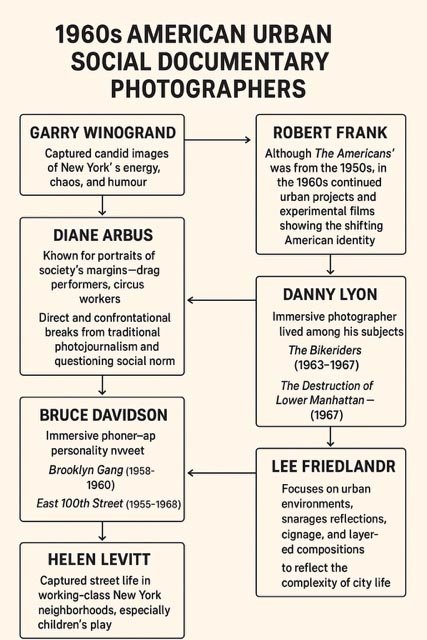In 1960s America, urban social documentary photography thrived during a period of civil rights activism, urban renewal, and cultural change. Several photographers made lasting contributions by documenting everyday life in cities, often focusing on marginalised communities and shifting social landscapes.
⸻
Key Urban Social Documentary Photographers – 1960s America
1. Garry Winogrand
• Street photographer whose candid images of New York captured the energy, chaos, and humour of urban life.
• Part of the emerging “snapshot aesthetic” that reflected social reality without staging.
⸻
2. Diane Arbus
• Known for portraits of people on society’s margins — drag performers, circus workers, and others often overlooked.
• Her direct, confrontational style broke from traditional photojournalism and questioned social norms.
⸻
3. Bruce Davidson
• Documented urban communities with empathy and depth.
• Key projects:
• Brooklyn Gang (1959–1960) – intimate portrayal of youth culture.
• East 100th Street (1966–1968) – a long-term study of a single Harlem block.
⸻
4. Danny Lyon
• Immersive photographer who lived among his subjects.
• The Bikeriders (1963–1967) and The Destruction of Lower Manhattan (1967) — documented subcultures and the effects of urban redevelopment.
⸻
5. Helen Levitt
• Captured street life in working-class New York neighbourhoods, especially children’s play.
• In the 1960s, she began using colour extensively, giving her urban scenes a lyrical warmth.
⸻
6. Lee Friedlander
• Focused on urban environments, often blending reflections, signage, and layered compositions to reflect the complexity of city life.
• Helped define a modern documentary style that was both personal and observational.
⸻
7. Robert Frank (late influence)
• While The Americans was from 1950s, in the 1960s he continued urban projects and experimental films showing the shifting American identity.
⸻
Common Themes:
• Civil rights and inequality.
• The rise of subcultures (motorcycle clubs, youth gangs).
• Urban renewal and the displacement of communities.
• A move from traditional photojournalism toward a more personal, subjective documentary style.
